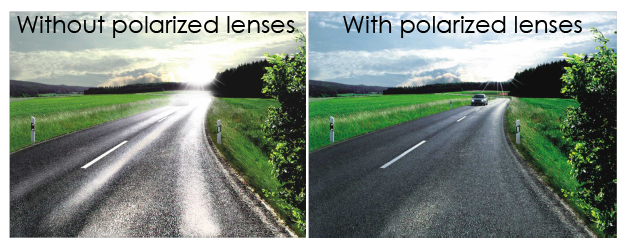Sunglasses
Polarised lenses can enhance your vision, colour contrast and visual comfort; together with blocking 100% of harmful UVA and UVB light emitted by the sun.
We've all experienced glare in our daily lives...perhaps spending the day at the beach, driving in a car with the sun reflecting off the dashboard, a wet road in bright daylight or the bonnet of your or oncoming cars.
Usually, this glare is irritating and uncomfortable on the eyes, but when the angle of reflection is just right, the glare can become unbearable and often dangerous whilst driving.
There are several types of tints/filters on the market for spectacles. Ordinary dip dyed tinted sunglasses' lenses only cut down on ambient light that reaches the eye, or, llight transmittance. By their very nature they cannot block glare. Only polarised lenses can block this.
To understand how, you will need to understand how polarised lenses work.
What is a Polarised Lens?
Polarised lenses are a laminated ophthalmic lens with tiny vertical stripes that only allow vertically angled light to enter the wearer's eyes.
Glare is emitted because the horizontal light waves cannot bypass the vertical laminated filter.
Sunglasses are often polarised to reduce glare from surfaces, such as light reflacting off a lake or the bonnet of a car, or the road in wet yet bright conditions.
Polarised Lens Benefits
Drivers, fishermen and photographers were some of the first to use polarised lenses. Reducing glare can ease the eye strain drivers feel from long hours on the road.
Fishermen can often see under the surface of the water using the lenses, which helps them to see fish or other objects. However, if you fish competitively they are usually banned due to gaining an advantage.
Photographers use polarising filters on camera lenses to enrich the images they capture by giving them more contrast and increase the range of effects they can produce. In addition to blocking glare, polarised lenses can also help you to see better by improving contrast and visual comfort.


